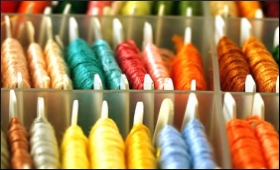|

|
Discourage raw material exports, apparel sector to govt.
|
|

|
|
| Top Stories |
 |
|
|
|
SME Times News Bureau | 07 May, 2010
The government must take more steps to discourage exports of raw material for the sake of finished clothing products in domestic and export markets, the Apparel Export Promotion Council (AEPC) said Thursday.
"The government must calibrate exports of raw material to encourage the textile and apparel sector which ranks as the second largest employment generator after agriculture," AEPC chairman Premal Udani said while addressing a press conference in New Delhi.
Though the government took some steps in this direction, the ground realities have not changed much, said Udani adding that fabric prices are still on the higher side compared to what they were in October-November last year while the availability is also not good.
"Massive exports of raw cotton and cotton yarn from India to neighbouring countries like China, Bangladesh and Pakistan in recent months have hurt our apparel industry," he pointed out.
The government, however, decided to halt cotton exports from April 19 - a move, which, according to a section of the industry, was too late as it came when the cotton season was drawing to a close and the best of the produce was already sent to overseas.
Udani viewed that a lot more remains to be done.
"In a country like ours where over 300 million people live below the poverty line, emphasis must be put on job creation and value-added segments like apparel exports," said Udani.
"At the same time, raw material exports must be dis-incentivised as they take jobs away from our country and create them in competing countries," he added.
Fabric prices have jumped 40 to 50 percent in the past six months, leading to cost escalations. Garment exporters cannot pass on these increases to their buyers, said Udani, nor can they absorb them as they are already under pressure due to strengthening of Indian rupee vis-Ã -vis US dollar and euro. Nearly one-third of garment manufacturing cost is on account of fabric price.
In 2009-10, apparel exports totaled 9.7 billion dollars compared to 10.95 billion dollars in the year-on period, marking a decline of 11.42 percent.
"A 10 percent growth in current fiscal year is a very optimistic scenario which may or may not happen, depending on access to raw material at reasonable rates."
The AEPC chairman called for full refund of taxes including state levies under the duty drawback scheme, duty-free scrips for exports to the United States and the European Union to be raised to five percent from the current level of two percent and interest subvention for small and medium enterprises to be extended to apparel sector.
AEPC stated that China imported 4.76 lakh tonnes of raw cotton from India during January to March this year which constituted 56 percent of its cotton imports. It also imported cotton yarn worth 5.5 million dollars from India, marking an increase of 136 percent over the same period of previous year in value terms and 183 percent in volume terms.
In the same period, Bangladeshâs imports of raw cotton from India totaled 42,000 tonnes and were pegged at 46.57 million dollars in value terms, it informed.
The Indian apparel industry employs seven million workers and half of them are engaged in the export sector. "With fluctuating value of Indian rupee against the US dollar and the euro, the profitability of export companies working on seven to eight percent operating margins has been badly hit," said Udani.
He urged the government to fix monthly quota and strict monitoring for calibrated exports of cotton yarns. This will help the domestic spinning industry as well, he added.
|
|
|
| |
|
|
|
|
|
|
|
Ban or implement some quota system on yarn export.
K.Senthil | Fri May 7 10:12:52 2010
AEPC chairman Mr. Premal Udani expressed the real problem of the garment exporters. Hope Govt. should take immediate action to ban on yarn export or implement some quota system to save the garment industry which ranks as the second largest employment generator.
It was too late of ban on raw cotton because it is a seasonal crop and we can’t produce immediately for our needs and it was already exported a lot to our competing country, now we are in short of raw cotton for our domestic market, if we still export the yarn by using the leftover cotton then it will force our garment industry to close.

|
|
|
|
|
|
|
| |
| Customs Exchange Rates |
| Currency |
Import |
Export |
US Dollar
|
84.35
|
82.60 |
UK Pound
|
106.35
|
102.90 |
Euro
|
92.50
|
89.35 |
| Japanese
Yen |
55.05 |
53.40 |
| As on 12 Oct, 2024 |
|
|
| Daily Poll |
 |
 |
| Do you think Indian businesses will be negatively affected by Trump's America First Policy? |
|
|
|
|
|
| Commented Stories |
 |
|
|
|
|
|
| |
|